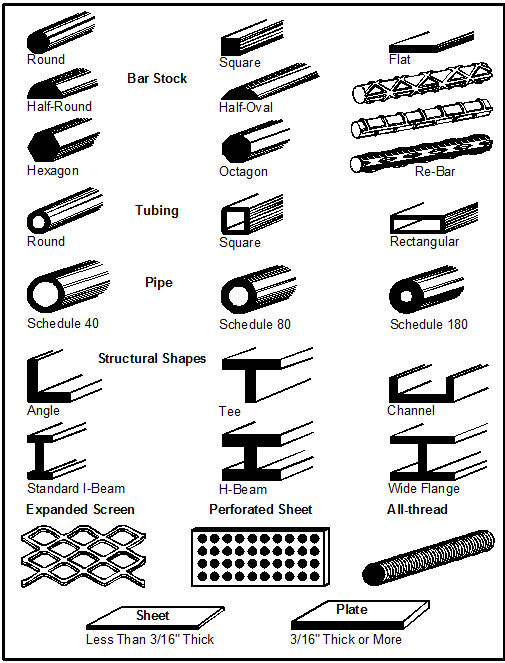- Title Page
- Copyright Page
- Contents
- Preface
- Acknowledgements
- Chapter 1: Setting Up Shop
- Chapter 2: Metals, Alloys, Oils & Hardness Testing
- Chapter 3: Tapers, Dowel Pins, Fasteners & Key Concepts
- Chapter 4: Filing & Grinding
- Chapter 5: Drilling, Reaming & Tapping
- Chapter 6: Bandsaws
- Chapter 7: Lathes
- Chapter 8: Milling Machines
- Chapter 9: Machine Shop Know How
- Index
- Credits
Chapter 2
Metals, Alloys, Oils Hardness Testing
Prediction is difficult—particularly when it involves the future.
—Mark Twain
Introduction
This chapter covers common sizes and shapes of steel products, common steel finishes, steel and aluminum numbering systems, steel categories, pipes and tubing, special steel products including stainless steel, rust prevention, metal hardness testing, metal hardening and the importance of metal grain direction.
Section I – Common Carbon Steel Sizes & Shapes
Carbon Steel Plate & Bar Sizes
Steel is available in the standard dimensions listed in Table 2-1.
|
Product |
Maximum |
Width or |
Incremental |
Sheet Steel |
> 3!16 |
36–84 |
Even-numbered gages are most common; odd-numbered gages are special order. |
Plate Steel |
[ 3!16 |
$8–60 |
1!32 – 1!2 thickness, then 1!16 – 1 thickness, then |
Rectangular
|
– |
á8 |
Thickness: 1!16 increments, but usually 1!8 increments. Width: 1!4 increments. |
Round Bars |
– |
á8 |
Diameter: 1!8 increments. |
Table 2-1. Product size, shape and increment availability of carbon steel.
Carbon Steel Products
Figure 2-1 shows many of the available carbon steel product that will work for most any project. A lot of the structural shapes—bar stock, plate, sheet and tubing—are also available in alloy steels, stainless steel, aluminum and brass.

Figure 2-1. Common carbon steel products.
Differences between Stock, Standard & Special
There are three terms you are likely to hear at a metal supply house—terms which suppliers are likely to redefine for their convenience and profit:
- Stock – Metal the supply house has on hand.
- Standard – Metal in a particular shape, size or alloy that is regularly produced by the industry. This material may or may not be in the steel seller’s inventory.
- Special – Metal forms, shapes, sizes and alloys not regularly produced. They are made for a specific customer.
Problems arise when standard products not in current stock are described as “special products” and are sold for a premium price. Do not tolerate this. Check the internet, other possible suppliers, or revise your design before accepting this answer and the high price that goes with it.
Section II – Carbon Steel Finishes
Finish vs. Alloy
The final process steel receives before leaving the mill determines its finish. Although some alloys and shapes are frequently made in a particular finish, the finish and alloy of a steel product—carbon content in the case of low-carbon steel—are two different, independent things. Alloy affects the physical and chemical properties of the steel—hardness, strength, rust resistance—while finish affects the steel’s surface finish or smoothness, how it accepts paint, and its ability to be bent without fracturing. In the case of cold-rolled steel, its finishing process increases its surface hardness. The three most common steel finishes are:
- Hot rolled
- Cold rolled
- Pickled and oiled
Hot-Rolled Steel (HRS)
After steel is produced in a basic oxygen, blast, or electric furnace, it is poured into ingots where it solidifies, but remains in a red-hot, plastic state. In the next step, these ingots are placed in a rolling mill and rolled back and forth through a series of shaped rollers that form the steel into a particular profile. Since the steel is relatively soft, intricate shapes may be formed. Because all rolling is performed in the plastic state, hot-rolled steel has little residual stress when cooled and is essentially in the annealed state. Hot-rolled stock tends to have rounded corners and edges.
When the hot steel is exposed to the atmosphere during rolling, a thick, tough, blue-gray oxide scale forms on its surface. This coloring is not uniform across a single product, nor uniform from piece to piece. No attempt is made to control its appearance. This characteristic scale is virtually inert and takes paint well, but should be removed before welding. Since it has a low carbon content, hot-rolled steel cannot be hardened by heat treatment, but can be case hardened.
Hot-rolled steel is readily bent, drilled and formed. With 25 standards forms, hot-rolled steel is available in sheet, plates, rods, tubes, welded-seam pipe and shapes. Products can be purchased in 12-foot, 20-foot and 40-foot lengths. While this material is readily machined, aside from structural applications, it finds little use in the machine shop.
Cold-Rolled Steel (CRS)
Cold-rolled steel differs from hot-rolled steel because its final rolling takes place at room temperature in an oil bath. Because its scale is removed before the cold-rolling step, the final product surface is the unoxidized gray of the steel itself. This final cold-rolling step induces surface stresses in the finished product. Although this makes the product stiffer than the same size or shape of hot-rolled steel, machining that removes material from just one side of the material often leads to warpage as the surface stresses produced by cold rolling become unbalanced. In general, except for the cold-rolling induced surface stresses, the inside structure of hot- and cold-rolled steel is the same. Thinner shapes tend to have the rolling-induced hardening all the way through, but with larger shapes only their outer shell is affected by rolling-induced hardening.
There are eight regularly available forms of cold-rolled steel: round bar, TGP (turned, ground and polished), square bar, hexagonal bar, flat bar, hydraulic tubing, coil and threaded rod with both National and Acme Threads.
Hot-Rolled vs. Cold-Rolled Steel
There are more hot-rolled steel forms than cold-rolled because rolling steel in the red-hot plastic condition permits intricate shapes to be formed that cold-rolling does not. Only simple shapes such as flats, hexes and rounds are available cold-rolled. Like hot-rolled steel, cold-rolled steel may be welded and case-hardened, but neither material can be hardened by heat treating. In general, using cold-rolled steel is a better starting point for machine parts than hot-rolled steel, which should be reserved for structures and reinforcement.
The advantages of cold-rolled steels:
- Stiffer and harder than hot-rolled steel of the same size.
- A surface finish free of oxidation.
- Sharper, better defined corners.
- Smoother surfaces.
- More accurate and consistent dimensions.
- No need to remove oxide before welding as with hot-rolled steel.
Some disadvantages of cold-rolled steels:
- More expensive than hot-rolled steel of the same size and shape.
- Fewer shapes to choose from.
- Rolling stresses imparted during cold-finishing can cause distortion if metal is removed from just one side of a part and stresses become unbalanced.
Pickled & Oiled Steel (P&O or HRP&O)
This is hot-rolled steel that has been:
- Pickled in hydrochloric acid to remove surface scale.
- Water rinsed and air dried.
- Slit on its edges to improve its width uniformity; an important feature in stamping and forming operations.
- Oiled to prevent rust before further processing.
Because these steels retain their hot-rolled properties, they bend without cracking, have better flatness than common hot-rolled steel, a better surface smoothness, paint adhesion and thickness uniformity. Steel with this finish goes into making appliances, steel pipe and tubing, auto parts, racking systems and containers.

